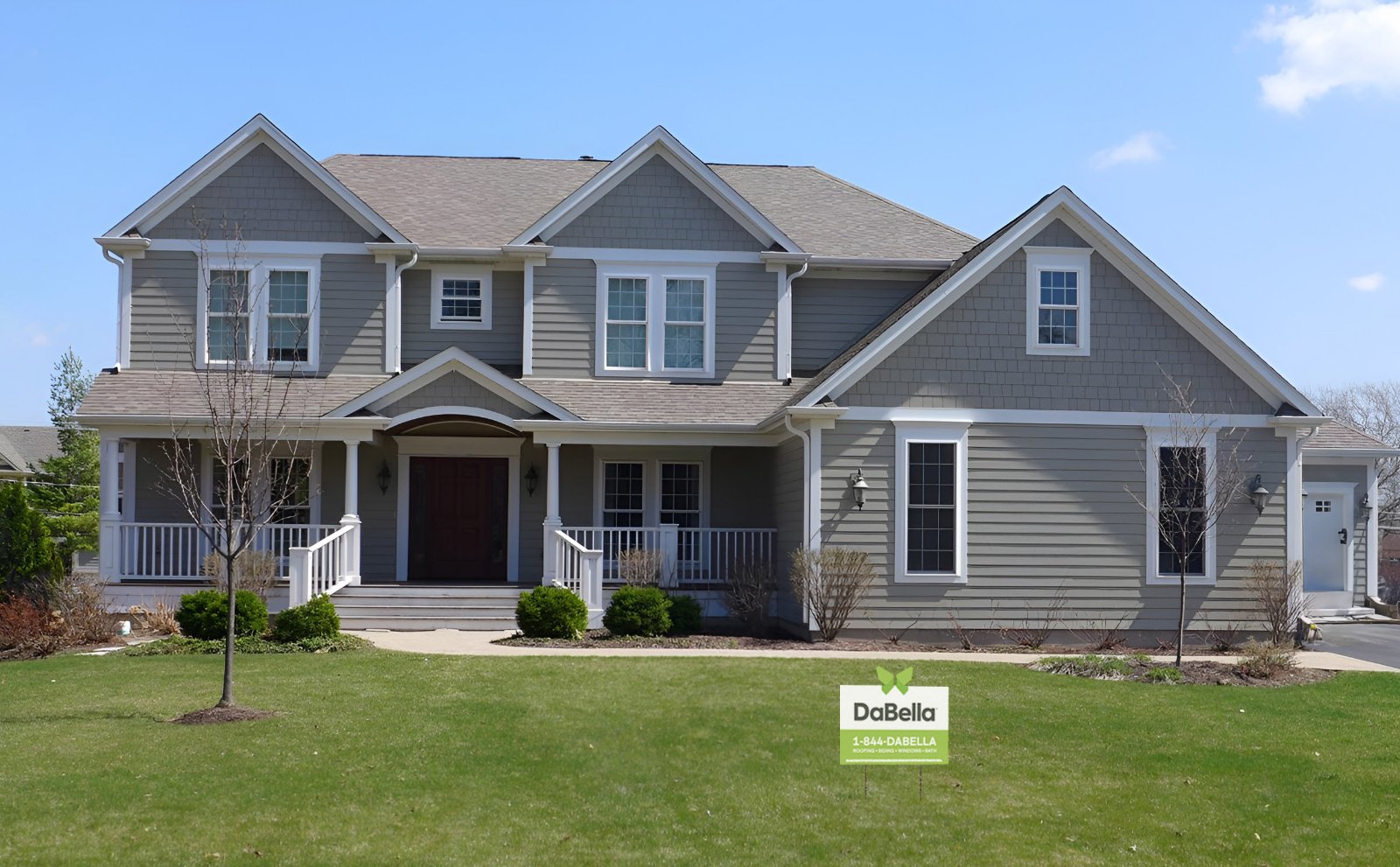If you own an aging home, you may be concerned about asbestos siding—a construction material commonly used decades ago that today is understood to pose serious health dangers. If your home was built before the mid 1980’s, understanding how to identify potential asbestos siding is crucial for your family’s safety and home maintenance planning. This guide explains the visual characteristics of asbestos siding, its history, associated health hazards, and proper procedures for handling this potentially dangerous material.
Asbestos siding was extensively used throughout much of the 20th century due to its durability, fire resistance, and low maintenance requirements. While these qualities made it an attractive option for builders and homeowners alike, we now understand the significant health concerns associated with asbestos exposure. Before undertaking any renovation work or addressing damaged siding on an older home, it’s essential to determine whether asbestos is present and follow proper safety protocols.
What Is Asbestos Siding?
Asbestos siding was a popular building material widely used throughout the United States from the early 1900s until the mid 1980s. This durable exterior material combined cement with asbestos fibers to create a product valued for its impressive fire resistance, insulating properties, and remarkable longevity. During its peak popularity in mid-century America, builders and homeowners chose asbestos siding for its ability to mimic the aesthetic appeal of traditional wood while requiring significantly less maintenance and offering superior weather resistance.
The construction industry embraced asbestos not only for siding but also incorporated it into numerous building products including roofing shingles, insulation materials, and flooring. Its unique combination of strength, fire resistance, and affordability made it a favorite among builders, despite the fact that its serious health implications remained largely unknown during this period. Asbestos siding earned its reputation by withstanding decades of exposure to harsh weather conditions without significant deterioration.
Dangers of Asbestos Siding
Despite its practical advantages, asbestos siding presents substantial health hazards when disturbed. When these materials deteriorate or undergo renovation work, microscopic asbestos fibers can become airborne and subsequently inhaled. This exposure has been definitively linked to serious respiratory conditions including asbestosis (scarring of lung tissue), lung cancer, and mesothelioma (a rare cancer affecting the lining of internal organs). With millions of homes built before 1980 potentially containing asbestos siding, proper identification and management of this material is crucial for homeowner safety. If you suspect your home features asbestos siding, professional testing and assessment should be your immediate next step, as proper handling requires specialized expertise and equipment.
How to Identify Asbestos Siding
Asbestos siding has distinct visual characteristics that can help with preliminary identification. Look for a rough, fibrous texture in siding panels that typically come in gray, white, or green colors. These sheets or panels often mimic wood or stone appearances and may display a slightly shiny surface caused by embedded asbestos fibers.
The age of your home provides important context for asbestos identification. Homes built before the 1980s commonly featured asbestos-containing materials, particularly in exterior siding applications. If your siding consists of cement-like materials with a brittle quality, it may contain asbestos. This contrasts sharply with modern siding options like vinyl or engineered wood, which have smoother, more uniform appearances and contain no asbestos. Check exterior walls, areas surrounding foundations, and garage exteriors carefully, as these were common installation locations.
Asbestos siding frequently served as a protective covering over wooden structures, making identification especially important before undertaking any renovation or repair projects. While visual inspection provides helpful clues, remember that only professional testing can definitively confirm asbestos presence in your home’s siding materials.
What to Do If You Suspect Asbestos Siding
If you believe your home might have asbestos siding, proceed with caution. Never disturb suspected asbestos materials, as this can release dangerous fibers into the air. Start by carefully examining the siding from a safe distance, looking for telltale signs like deteriorating edges, unusual patterns, or damage to the material. Remember that visual inspection alone isn’t conclusive—only laboratory testing by qualified professionals can definitively confirm asbestos presence.
Safety should be your top priority when dealing with potential asbestos. If you notice damaged siding or plan renovation work, avoid DIY removal or repairs at all costs. Instead, restrict access to the area to prevent accidental disturbance. While temporary protective gear like masks and gloves provide minimal protection if you must be near the area, the safest approach is keeping clear until professional assessment.
Should testing confirm asbestos or if the siding shows significant deterioration, immediately contact a certified asbestos abatement contractor. These specialists have the proper training, equipment, and certifications to safely handle asbestos materials—either through removal or encapsulation—while following all regulatory requirements. Taking these precautions ensures both your family’s safety and compliance with local health regulations.
What is the Process for Removing Asbestos Siding?
The removal of asbestos siding begins with professional testing to confirm its presence. Once verified, certified abatement contractors develop a detailed removal plan that complies with all regulations and obtain necessary permits. Before work begins, the area is completely sealed with plastic sheeting, warning signs are posted, and negative air pressure systems with HEPA filters are installed. Workers wear full protective equipment including respirators and disposable coveralls.
During removal, the siding is thoroughly wetted to prevent fiber release, carefully removed intact when possible, and immediately placed in sealed containers. After all materials are removed, the area undergoes extensive cleaning with HEPA vacuums and wet-wiping. All waste is properly sealed and transported to authorized disposal facilities. Finally, air quality testing verifies the area is safe before containment measures are removed and new siding can be installed. This entire process must be conducted by licensed professionals due to the serious health risks associated with asbestos exposure.
FAQ’s: Asbestos Siding
Our most frequently asked questions when homeowners reach out about their siding:
Does asbestos siding need to be replaced?
Asbestos siding doesn’t require removal by law if it’s intact and stable. The material only creates health risks when broken, deteriorating, or disturbed during construction work—that’s when dangerous fibers become airborne. Homes built before 1980 often still have original asbestos siding that poses little threat when left alone. Replace it when panels crack, chip, or crumble, as damaged material releases fibers. Consider removal if you’re planning major exterior work, want a fresh appearance, or simply prefer eliminating the concern. Maintaining asbestos siding means repainting every five to seven years, and tracking down matching replacement pieces for damaged sections proves difficult. Removal requires licensed abatement contractors who follow strict EPA protocols—never attempt DIY removal.
What did asbestos siding look like?
Asbestos siding came in 12-by-24-inch panels with a dense, chalky texture that feels heavier than modern alternatives. Colors ranged from gray and white to tan and green, often fading significantly over decades. Look for two or three nail holes at each panel’s bottom, pressed wood grain textures, or wavy decorative patterns along the lower edge. The material sounds sharp and ceramic-like when tapped, quite different from wood or vinyl. Manufacturers designed asbestos siding to mimic natural materials like wood shakes or clapboard. Multiple paint layers typically cover older installations. Visual inspection alone can’t confirm asbestos—only lab testing provides certainty. Modern fiber cement looks similar but includes manufacturer stamps on the back, while asbestos products lack these codes.
Can a house be sold with asbestos siding?
Yes, homes with asbestos siding sell regularly, though disclosure rules depend on your state. Federal regulations don’t mandate asbestos disclosure for residential sales, but most states require sellers to reveal known hazards on disclosure forms. California and Texas enforce strict disclosure standards, while other states take lighter approaches. Failing to disclose known asbestos opens you to fraud claims and lawsuits after closing. You don’t need to remove asbestos before listing—intact siding poses minimal risk. Buyers might request price reductions or repair credits during negotiations, though many accept asbestos siding on older homes where it’s expected. Real estate agents experienced with older properties help manage disclosure requirements and buyer reactions. Selling as-is to investors or cash buyers works if removal costs exceed your budget.
Who to Contact for Asbestos Abatement
If you suspect your home contains asbestos siding, it’s essential to seek professional assistance for testing and safe removal. This hazardous material requires specialized handling by qualified contractors with proper equipment and training for asbestos abatement. While we don’t provide asbestos house siding abatement services, many certified companies specialize in this critical work.
When selecting an asbestos abatement contractor, verify they hold proper licensing and insurance specific to hazardous material handling. Look for specialists with extensive experience in asbestos removal, as improper procedures can create serious health risks. Before making your decision, thoroughly vet potential contractors by checking credentials, reading customer reviews, and requesting references from previous clients. Ask detailed questions about their safety protocols, removal methods, and comprehensive project plan—including testing, removal, containment, and cleanup procedures.
Once you’ve confirmed your home is asbestos-free or had existing asbestos properly remediated, contact us at 844-DaBella for your next siding replacement project. Our team is ready to help transform your home with quality siding products and professional installation services.

